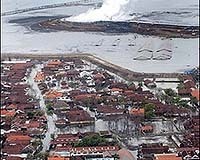
|
| ©AFP |
| An aerial view from March, 2007 shows mud that oozed and covered some 600 hectares (1,482 acres) in the area of Porong, a district of Sidoarjo in East Java. |
Jakarta - Workers were racing Thursday to repair a massive wall holding back sludge spewing from Indonesia's "mud volcano" that has already flooded hundreds of homes, an official said. Cracks started to appear in the man-made embankment around the disaster area in east Java on Wednesday, prompting authorities to declare the area off limits.
Bambang Suryadi, from the company charged with monitoring the site, said a 300-metre exclusion zone was thrown up only as a precaution, saying the situation was not severe.
"We are already working to repair the cracks, there does not appear to be any problem," said Suryadi from Pt Fergaco.
But state Antara news agency reported the cracks had sparked panic among workers charged with reinforcing the embankment.
It was built months after the volcano started spewing sludge last May, in an attempt to reduce the disastrous impact on surrounding areas.
The flow has damaged roads and swamped farms, factories and homes, displacing 15,000 residents and causing millions of dollars worth of damage.
Some 600 hectares (1,500 acres) have been inundated.
The volcano, near Indonesia's second-largest city of Surabaya, has been blamed on exploratory gas drilling which pierced a layer of strata under pressure several thousand metres deep.
The repairs come as engineers worked on a device to determine if efforts to halt the damage have had any success.
Engineer Satria Bijaksana said although the volcano was still spewing mud, it would determine if hundreds of concrete balls dropped into its funnel had started to ease the flow.
Bijaksana said the new device, still being designed, would take a series of measurements from inside the funnel.
The dropping of the balls was halted after the government appointed an agency this month to deal with the volcano and assess its socio-economic impact, he said.
"We have been asked by the new team, to propose a device to measure various aspects, such as the profile of the main vent, the depth the balls have reached, and the pressure at that point," Bijaksana told AFP.
"Only after we have that device and after measurements are made can we decide on the next steps (to take). They may include many more concrete balls being dropped but we cannot say yet," he said.
A design must be submitted to the government-backed agency by the end of the week.
Experts have already dropped hundreds of chains, each comprising four concrete balls, into the crater, aiming to narrow the funnel, obstruct the sludge and curb the flow.
Experts are unsure how long the crater will spew mud if left unchecked, with some suggesting it could be years.



Reader Comments
to our Newsletter